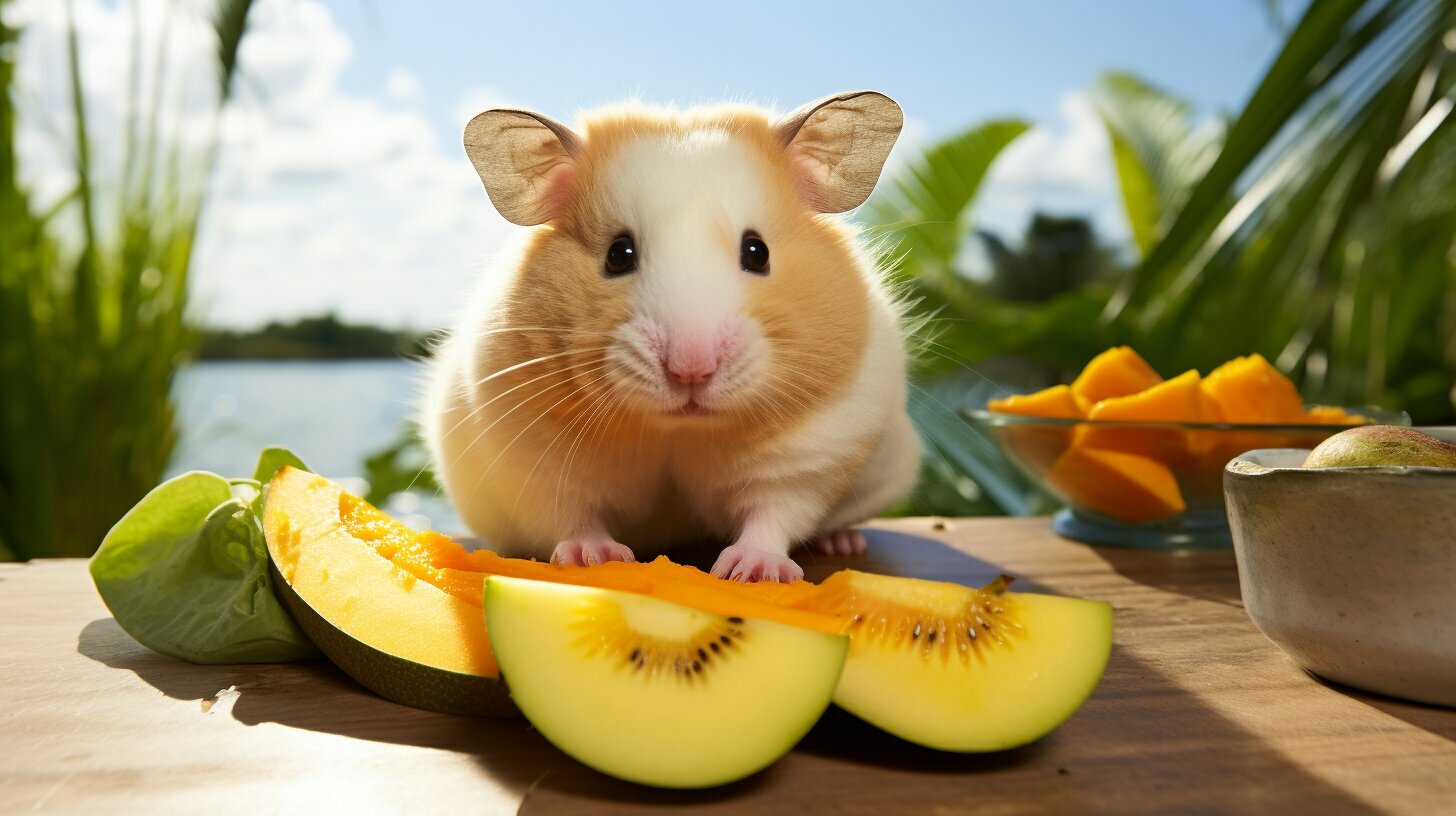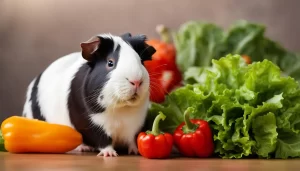Mango is a delicious tropical fruit, but can hamsters enjoy this tasty treat too? As a hamster owner, you may wonder whether it is safe to include mango in your pet’s diet. In this article, we will explore the potential benefits and risks of feeding mango to hamsters, along with guidelines to ensure their well-being.
Key Takeaways:
- Hamsters can eat mango in moderation.
- Mangoes are rich in vitamin C, minerals, and fiber.
- Peel the mango before feeding it to hamsters to avoid choking hazards.
- Feeding excessive amounts of mango can lead to diabetes and obesity in hamsters.
- Offer small pieces of fresh or dried mango as occasional snacks.
The Benefits of Mango for Hamsters
Mangoes are packed with essential nutrients that can contribute to your hamster’s overall well-being. These tropical fruits are not only delicious but also provide a range of health benefits for your furry friend.
One of the key benefits of mango for hamsters is its high content of vitamin C. Vitamin C is essential for the proper functioning of their immune system, helping to ward off illnesses and keep them in good health. By including mango in their diet, you can help ensure that your hamster gets an adequate amount of this important vitamin.
In addition to vitamin C, mangoes also contain a variety of essential minerals such as potassium and magnesium. These minerals play a vital role in supporting the proper functioning of your hamster’s body and contribute to their overall well-being. The fiber content in mangoes can also aid in digestion, promoting a healthy digestive system for your pet.
| Vitamins | Minerals | Fiber |
|---|---|---|
| Vitamin C | Potassium | Fiber |
| Magnesium | ||
While mangoes offer numerous benefits, it’s important to remember that moderation is key. Feeding your hamster excessive amounts of mango can have negative consequences, such as increased risk of diabetes and obesity. It’s best to offer small pieces of fresh or dried mango as occasional snacks, rather than making it a significant portion of their daily diet.
When feeding mango to your hamster, be sure to peel the fruit to avoid any choking hazards. It’s also important to avoid feeding them mango peels or seeds as they can be harmful to their digestive system.
Pro Tip:
Remember to always consult your veterinarian before making any significant changes to your hamster’s diet, including adding mango. They can provide personalized advice based on your hamster’s specific needs and health condition.
Summary:
- Mangoes are packed with essential nutrients such as vitamin C, minerals, and fiber that can contribute to your hamster’s overall well-being.
- Hamsters can benefit from the immune-boosting properties of vitamin C found in mangoes.
- The potassium and magnesium in mangoes support proper body functioning and the fiber aids in digestion.
- Feeding mangoes to hamsters should be done in moderation to prevent diabetes and obesity.
- Remember to peel the mango before feeding it to your hamster and avoid giving them the peels or seeds.
- Consult your veterinarian for personalized advice on adding mango to your hamster’s diet.
Precautions for Feeding Mango to Hamsters
While mango can be beneficial for hamsters, it’s essential to take some precautions to ensure their safety and well-being. Here are some important guidelines to follow when feeding your hamster mango:
- Peel the mango: Before offering mango to your hamster, it’s crucial to peel the fruit to prevent any choking hazards. Mango skin can be tough and difficult for hamsters to digest, so removing the peel is necessary.
- Avoid mango seeds and pits: Hamsters should not be given mango seeds or pits. These parts of the fruit can be a choking hazard and may cause intestinal blockages if ingested.
- Moderation is key: While mango can provide nutritional benefits, it should only be given to hamsters in moderation. Feeding them excessive amounts of mango can lead to health issues such as obesity and diabetes. Stick to small pieces of fresh or dried mango as occasional treats.
It’s important to remember that hamsters have specific dietary needs, and their main diet should consist of hamster pellets and fresh vegetables. Mango should only be offered as a supplement to their regular diet.
By following these precautions, you can safely introduce mango into your hamster’s diet and provide them with a tasty and nutritious snack. Remember to consult with a veterinarian if you have any concerns or questions regarding your hamster’s diet.
| Precautions for Feeding Mango to Hamsters |
|---|
| 1. Peel the mango |
| 2. Avoid mango seeds and pits |
| 3. Moderation is key |
Moderation is Key
When it comes to feeding mango to your hamster, remember that moderation is key. Mangoes can be a healthy addition to their diet, thanks to their high content of vitamin C, essential minerals, and fiber. However, it’s important to offer mango in small portions and as an occasional treat rather than a regular meal.
Feeding your hamster too much mango can lead to health issues such as diabetes and obesity. Just like with any other fruit or treat, it’s essential to maintain a balanced diet for your furry friend. While mango offers nutritional benefits, it should be given in appropriate portion sizes to avoid any potential complications.
When introducing mango to your hamster, make sure to peel the fruit to prevent any choking hazards. Mango peels are not safe for consumption and should be discarded. Additionally, avoid feeding your hamster mango seeds, as they can pose a risk to their digestive system. By following these precautions, you can ensure the well-being of your hamster when enjoying this tropical fruit.
Incorporating both fresh and dried mango into your hamster’s diet can provide a variety of textures and flavors. However, be mindful of the sugar content in dried mango, as it can be higher than in fresh mango. Consider offering small pieces of fresh mango as a refreshing snack, while dried mango can be given occasionally as a chewy treat.
| Do’s | Don’ts |
|---|---|
|
|
By following these feeding guidelines, you can ensure that your hamster enjoys the benefits of mango while minimizing any potential risks. Remember to always prioritize your hamster’s well-being and consult with a veterinarian if you have any concerns about their diet or health.
Diabetes and Obesity Risks
While hamsters can enjoy mango as a treat, it’s crucial to be aware of the risks of overindulgence. Feeding hamsters excessive amounts of mango can lead to diabetes and obesity, which can have serious consequences for their health. It is important to understand the potential risks and take appropriate precautions to ensure your hamster remains in optimal condition.
Mango, like other fruits, contains natural sugars. While these sugars are generally considered healthier than refined sugars found in processed foods, it is still important to monitor the amount of sugar your hamster consumes. Overconsumption of sugary foods can disrupt their blood sugar levels and increase the risk of developing diabetes.
Obesity is another concern when it comes to feeding mango to hamsters. Excessive mango consumption can contribute to weight gain, which can lead to a range of health issues including joint problems, heart disease, and a decreased lifespan. It is important to remember that hamsters have small bodies and are naturally prone to weight gain, so portion control is essential.
| Risk | Precautions |
|---|---|
| Diabetes | Avoid feeding hamsters large quantities of mango. Offer small pieces occasionally as a treat. |
| Obesity | Monitor your hamster’s weight and body condition. Limit the amount of mango offered and ensure their overall diet is well-balanced. |
By understanding these risks and taking appropriate precautions, you can still incorporate mango into your hamster’s diet without compromising their health. Remember to always prioritize moderation and consult with a veterinarian if you have any concerns or questions regarding your hamster’s diet.
How to Feed Mango to Hamsters
Introducing mango into your hamster’s diet can be done safely with the right approach. Mangoes are nutritious fruits that can provide a range of health benefits for your furry friend. However, it’s important to follow certain guidelines to ensure their well-being. Here are some tips on how to feed mango to hamsters:
- Peel the mango: Before offering mango to your hamster, make sure to peel off the skin. The skin can be difficult for hamsters to digest and may pose a choking hazard. By removing the skin, you can eliminate any potential risks.
- Cut into small pieces: Once the mango is peeled, cut it into small, bite-sized pieces that are easy for your hamster to chew and swallow. This will help prevent any choking incidents and make it easier for them to enjoy their snack.
- Offer in moderation: While mango can be a healthy treat for hamsters, it should be offered in moderation. Too much mango can lead to an imbalance in their diet and potentially cause health issues such as diabetes and obesity. Aim for occasional servings of small mango pieces as a special treat.
Including a variety of fruits and vegetables in your hamster’s diet is essential for their overall health. Mango can be a great addition to their diet, but it should not replace their regular food. Remember to provide a balanced and varied diet to ensure they receive all the necessary nutrients.
| Benefits of Feeding Mango to Hamsters | Precautions for Feeding Mango to Hamsters |
|---|---|
|
|
By following these guidelines, you can safely incorporate mango into your hamster’s diet. Remember to always observe your hamster’s reaction to new foods and consult a veterinarian if you have any concerns. With the right approach, mango can be a delicious and nutritious treat for your beloved hamster.
Feeding Do’s and Don’ts
To ensure your hamster’s safety and health, here are some essential do’s and don’ts when it comes to feeding them mango:
- Do: Offer small pieces of fresh or dried mango as an occasional treat. Mango can provide hamsters with essential vitamins, minerals, and fiber.
- Do: Peel the mango before feeding it to your hamster. This helps prevent choking hazards and ensures their safety.
- Do: Introduce mango gradually into their diet to avoid any digestive issues. Start with small portions and monitor their response.
- Don’t: Feed your hamster mango peels or seeds. These parts of the fruit can be difficult for hamsters to digest and may cause harm.
- Don’t: Overfeed mango to your hamster. While it can be a healthy addition to their diet, excessive consumption can lead to obesity and diabetes.
Remember, moderation is key when it comes to feeding mango to your hamster. Offering small amounts as an occasional treat will help maintain their overall health and well-being.
Giving Your Hamster a Balanced Diet
While mango can be a tasty and nutritious treat for your hamster, it’s important to remember that it should be part of a balanced diet. Along with mango, consider incorporating other suitable foods to ensure your furry friend receives all the necessary nutrients.
A balanced hamster diet typically includes a variety of seeds, grains, fresh vegetables, and occasional fruits. Consult with a veterinarian or do thorough research to determine the appropriate portion sizes and types of food to include in their diet.
| Food Group | Serving Size | Frequency |
|---|---|---|
| Seeds and Grains | 1-2 tablespoons | Daily |
| Fresh Vegetables | 1-2 tablespoons | Daily |
| Fruits (including mango) | 1-2 small pieces | Occasional treat |
By providing a well-balanced diet, you can ensure your hamster stays healthy and happy. Remember to always monitor their intake and consult a veterinarian if you have any concerns.
Fresh vs. Dried Mango: Which is Better for Your Hamster’s Diet?
Do you have fresh mango or dried mango? Discover which option is better for your hamster’s diet. Mango is a delicious and nutritious fruit that can be a healthy addition to your hamster’s diet when offered in appropriate moderation. However, when it comes to choosing between fresh and dried mango, there are a few factors to consider.
One advantage of fresh mango is its high water content, which can help keep your hamster hydrated. Fresh mango also contains higher levels of vitamin C, an essential nutrient that supports your hamster’s immune system. Additionally, the vibrant colors and juicy texture of fresh mango can provide sensory enrichment for your furry friend.
Fresh mango is a great option for hamsters as long as it is given in small, appropriate portions.
On the other hand, dried mango offers some benefits as well. Drying the fruit removes the water content, resulting in a more concentrated source of nutrients. It can be a convenient option for storage and can have a longer shelf life compared to fresh mango. Dried mango also provides a chewy texture that can help promote dental health for your hamster.
However, it’s important to note that dried mango often contains added sugars or preservatives, which can be harmful to your hamster’s health. It is crucial to choose dried mango without any additives and offer it sparingly as an occasional treat. Always check the ingredient list and opt for natural, unsweetened dried mango to ensure your hamster’s well-being.
| Benefits of Fresh Mango | Benefits of Dried Mango |
|---|---|
|
|
Considerations for Choosing
When choosing between fresh and dried mango for your hamster, it’s important to consider their individual needs and preferences. Some hamsters may prefer the juicy texture and freshness of fresh mango, while others may enjoy the chewiness of dried mango. You can offer small pieces of both options and observe your hamster’s response to determine which they prefer.
In conclusion, both fresh and dried mango can be suitable for your hamster’s diet, but it’s crucial to offer them in moderation and ensure they are free from any additives or sugars. Remember to peel the mango and remove any seeds before providing it to your hamster. By incorporating mango into their diet alongside other balanced sources of nutrition, you can provide your hamster with a healthy and varied diet that supports their overall well-being.
Considerations for a Balanced Diet
Including mango in your hamster’s diet is just one piece of the puzzle for maintaining their overall health. While mangoes can provide essential nutrients, it is important to ensure a balanced diet by incorporating a variety of suitable foods. This will help meet their nutritional needs and prevent any potential health complications.
When adding mango to your hamster’s diet, it is crucial to offer it in appropriate portion sizes. Too much mango can lead to diabetes and obesity in hamsters, so moderation is key. Providing small pieces of fresh or dried mango as occasional snacks will help prevent excessive consumption and maintain a healthy balance.
To ensure your hamster’s safety, always peel the mango before feeding it to them. Mango peels can pose a choking hazard and should be avoided. Additionally, remember not to feed them mango seeds, as they can be harmful to their digestive system.
| Do’s | Don’ts |
|---|---|
|
|
By following these guidelines, you can safely incorporate mango into your hamster’s diet. Remember that mango should not be the sole component of their nutrition and should be supplemented with other suitable foods to maintain a balanced diet. Always observe your hamster’s response to new foods and consult a veterinarian if you have any concerns.
Conclusion
In conclusion, hamsters can enjoy mango as part of a balanced diet, but it’s crucial to be mindful of portion sizes and potential risks to ensure their well-being. Mangoes are a healthy fruit option for hamsters, as they are rich in vitamin C, minerals, and fiber. However, it is important to peel the mango before feeding it to your hamster to avoid any choking hazards. Feeding a large amount of mango regularly can lead to diabetes and obesity in hamsters, so it’s essential to offer small pieces of fresh or dried mango as occasional snacks.
When introducing mango into your hamster’s diet, remember that they should not be fed mango peels or seeds. These parts of the fruit can pose health risks to your furry friend. Moderation is key when it comes to feeding mango to hamsters. By offering mango in appropriate portion sizes and alongside a balanced diet, you can ensure that your hamster receives the nutritional benefits without any adverse effects.
It’s important to note that mango should not be the sole food in your hamster’s diet. A variety of other suitable foods should be provided to ensure optimal nutrition. Mango can be a delightful and nutritious addition, but it should be supplemented with other fruits, vegetables, and hamster pellets to provide a well-rounded diet.
Always monitor your hamster’s reaction to mango and any other food you introduce. If you notice any signs of digestive issues or allergies, it’s best to consult a veterinarian. By following these guidelines and being attentive to your hamster’s needs, you can safely incorporate mango into their diet and offer them a tasty treat that they will love.
FAQ
Q: Can hamsters eat mango?
A: Yes, hamsters can eat mango in moderation.
Q: What are the benefits of mango for hamsters?
A: Mangoes are healthy for hamsters as they contain high amounts of vitamin C, minerals, and fiber.
Q: Are there any precautions for feeding mango to hamsters?
A: Yes, it is important to peel the mango before feeding it to the hamster to avoid choking hazards.
Q: Is moderation important when feeding mango to hamsters?
A: Yes, feeding a large amount of mango regularly can lead to diabetes and obesity in hamsters. It is recommended to offer small pieces of fresh or dried mango as occasional snacks.
Q: What are the risks of diabetes and obesity associated with mango consumption in hamsters?
A: Feeding hamsters excessive amounts of mango can increase the risk of diabetes and obesity.
Q: How should mango be fed to hamsters?
A: It is important to offer small pieces of fresh or dried mango in appropriate portion sizes as occasional snacks.
Q: What are the do’s and don’ts of feeding mango to hamsters?
A: Do peel the mango and offer small pieces as occasional treats. Don’t feed them mango peels or seeds.
Q: Is there a difference between feeding fresh and dried mango to hamsters?
A: There may be differences in texture and nutritional content between fresh and dried mango. Both can be offered to hamsters, but moderation is key.
Q: Should mango be part of a hamster’s balanced diet?
A: Mango can be a healthy addition to a hamster’s diet when given in appropriate portion sizes alongside other suitable foods for optimal nutrition.




